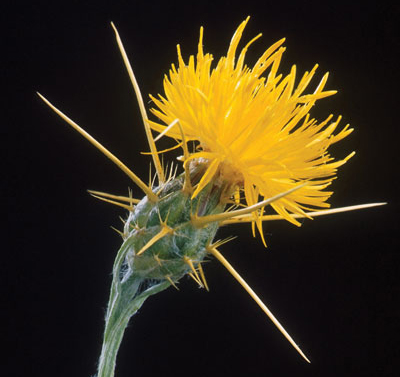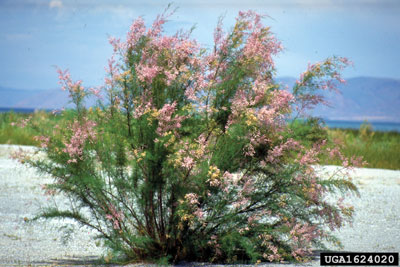
Features
Agronomy
Other Crops
A timely update on the Weed Acts
In 2010, new weed control legislation came into force in Alberta and Saskatchewan.
November 21, 2011 By Lisa Guenther
In 2010, new weed control legislation came into force in Alberta and Saskatchewan. The new legislation has ramifications for producers, municipalities and others in the agriculture industry.
 |
|
| Yellow starthistle is listed as a prohibited weed in Saskatchewan and a prohibited noxious weed in Alberta. Photo courtesy of Peggy Greb, USDA Agricultural Research Service.
|
One of the biggest changes to Saskatchewan’s weed control legislation is in how weeds are categorized. Clark Brenzil, weed control specialist with Saskatchewan Agriculture, says that Saskatchewan’s previous weed control legislation was not effective in setting priorities for controlling the different weed species listed. “Some municipalities, rightly so, set an aggressive spreading weed like scentless chamomile as a higher priority than a common weed like wild oats, but both had equal importance under the old legislation. When municipalities went to enforce the legislation, they sometimes got the response, ‘Well, what about that field of wild oats over there?’” explains Brenzil.
The Weed Control Act in Saskatchewan now divides weeds into three categories: prohibited, noxious and nuisance. Prohibited weeds include species that are absent from, or rare to, Saskatchewan. Examples include saltcedar and yellow starthistle. If a weed inspector finds a prohibited weed, steps are taken to eradicate it.
Noxious weeds include plants that are well established in some areas of Saskatchewan, but are absent from other areas, such as scentless chamomile and leafy spurge. For these noxious weeds, the focus is on containment and integrated control measures. However, if the infestation is less than five hectares (12.35 acres) per quarter section, the legislation calls for eradication.
Saskatchewan’s nuisance category includes weeds that are common, but spread easily, such as dandelion and foxtail barley. Unlike the other two categories, municipal staff must receive a complaint before they can issue a notice for a nuisance weed. Landowners will be asked to bring the weeds under control to a level that is more in step with adjacent land. Brenzil notes that many of the very common weeds, such as wild oats and wild buckwheat, were dropped from the list.
The committee that drafted Alberta’s Weed Control Act decided to drop the nuisance category altogether. “The main reason we got rid of the nuisance list was that in our old Act there was nothing you could do on a nuisance weed. You couldn’t issue a notice on a nuisance weed. So it was just a list of very, very common weeds,” explains Paul Laflamme, head of Alberta Agriculture and Rural Development’s Pest Surveillance Branch.
The categories in Alberta’s Weed Control Act are similar to those in Saskatchewan’s legislation. Alberta’s prohibited noxious category includes 49 invasive plants that are problems in neighbouring provinces and states but are not yet established in Alberta. The 26 noxious weeds are already found within Alberta, but can still be controlled. In both cases, municipalities will issue a notice to landowners, and landowners must follow the directions on that notice to destroy prohibited noxious weeds and control noxious weeds.
Municipalities responsible for enforcement
Albertans who receive a weed control notice may appeal to a committee. The appeal fees have increased, although the fee is refunded if the appellant wins. Appeal committees are now required to meet within five days, rather than the 15 days specified under the old Act. “The weeds, a lot of the time, were going to seed before the appeal committee met to make these decisions,” says Laflamme.
 |
|
| Saltcedar is a prohibited weed in Saskatchewan and a prohibited noxious weed in Alberta. Photo courtesy of Dr. Steve Dewey, Utah State University.
|
Saskatchewan has added a new appeal process. Under Saskatchewan’s weed control legislation, a person can appeal to the municipality. If they are unsatisfied with the municipality’s decision, the person can then appeal to the Saskatchewan Municipal Board, which handles other appeals as well.
Both provinces allow municipalities to step in and recover their costs if a landowner refuses to comply with a notice. Saskatchewan has increased the maximum fine from $500 to $5000, though Brenzil says that fines are not handed out for simply having a regulated weed; fines are generally directed at people who fail to co-operate during the enforcement process. “It is not a simple process for a municipality to collect a fine since they will have to make their case before a provincial judge,” Brenzil explains.
Landowners are not the only ones affected by the new Act. Saskatchewan’s weed control legislation also includes penalties for moving material, machines or domestic animals infested with regulated weeds without the consent of a weed inspector. A person can also be fined for depositing prohibited or noxious weeds in an area where the weeds might grow or spread.
In Alberta, vehicles hauling grain must be tarped to prevent unintentional contamination. If an agricultural field man suspects that weeds are being spread through hauled hay, he can issue a notice halting hay transport or requiring that hay be tarped. Alberta has also closed loopholes in previous legislation that allowed mobile seed cleaning plants to operate without a licence by leasing equipment to farmers.
Municipalities in both provinces are responsible for enforcement. If an Alberta municipality is not enforcing the Weed Control Act, the government can step in, take steps to control the weeds, and charge the costs back to the municipality.
Municipalities in Saskatchewan do not necessarily have to appoint a weed inspector. However, ratepayers can demand a weed inspector, and the weed inspector must be active for 24 months after the time of the ratepayers’ petition. The municipality is also liable for negligence on the part of the weed inspector, which could include failing to enforce weed control legislation.
Brenzil says Saskatchewan municipalities are still adapting to the new Act. “This new legislation is a big change from the previous law that had remained roughly the same for nearly 50 years, with only minor changes,” he remarks.
In Alberta, Laflamme says the increase in awareness around the new Act has been phenomenal. In fact, some of the weeds on the prohibited noxious list are more common in Alberta than initially thought. “Once people knew about the plants, knew what they looked like and started looking for them, it was surprising what we found,” he says, adding that they are considering moving some of these weeds to the noxious category.
Information on both Acts is available on the Saskatchewan Agriculture and Alberta Agriculture and Rural Development websites.